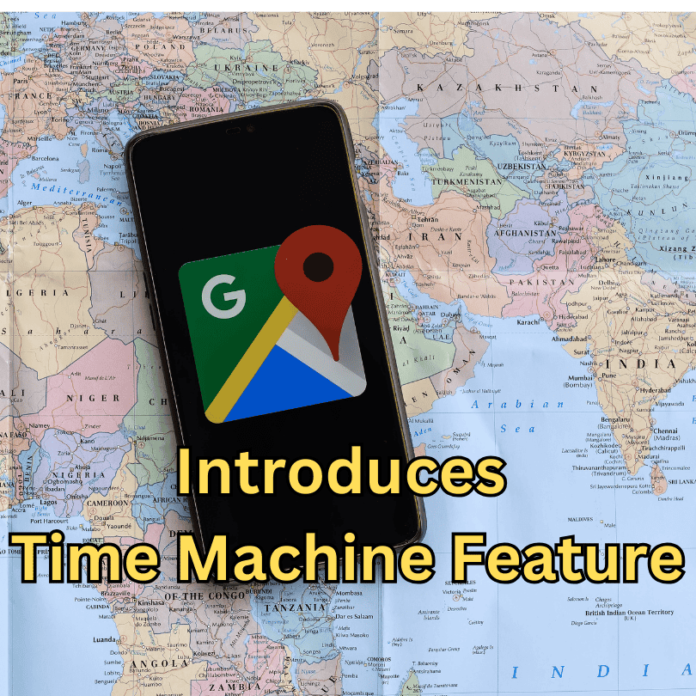Google Maps Introduces Time Machine Feature – With the help of time-lapse technology, we leave the passive powerless observer behind and bring the power of actual change to the people’s fingertips. What makes heads turn now is the feature that Google Maps, the most preferred interface for navigation and mapping internationally, has introduced. This exciting addition enables users to navigate through their localities as they were in the past changing how we deal with geography and history.
Idea Behind the Time Machine
The Time Machine feature draws upon Google’s arsenal of potentially billions of historical imagery and mapping information that has taken years in satellite imaging, Street View captures, as well as inputs from users. The concept is to give the users a chance to experience the historical development of one or another district, city, or even the whole landscape. A single mouse click takes you from the current view to historical view which gives you a glimpse of what the environment looked like in the past.
Some people probably viewed older buildings as boring, but this feature is an excellent learning opportunity to consider the appearance of cities, climate, and people alter. In other words, one may look at how, for example, a park which used to be green has been constructed to pave way for a new building; how a river has changed its course over years.
Table of Contents
Exploring the Past
It is easy to use the Time Machine feature. The manipulation is quite simple, when you type an address in the search bar of Google Maps, a new button labeled as “Time Machine” appears on the service interface. The years to be displayed by clicking this button can be selected by the users conveniently. This functionality is highly stimulating in regions with focused histories of change such as Semirechensk, countries, towns or regions that have experienced growth and change of use, or regions that witnessed certain events such as rural areas.
Think it would be possible to see what childhood neighborhood looked like from the warmth of one’s living room? This way you can see the houses that were collapsed and new built constructions have replaced them or the empty fields which are developed into commercial complexes today. Similarly, the sort of capabilities mentioned above make it possible to develop not only the personification of local history, but also appreciation of its value.
Learning Resources
Apart from the individual search, the Time Machine option creates an opportunity for teachers and learners. This tool can be adopted by teachers for use in their classroom practices and let students make comparisons on geographical shifts, planning and even environmental effects. For instance, a lesson on metropolitan growth can be greatly complemented by presenting the students with growth of cities over times. In the same manner, history courses are improved with visuals of important landmarks in order to give reference to events in historical books.
Local governments and historians may also find the Time Machine feature very helpful. For urban planner, HLI data can be used to study and predict patterns of land use in a city; for historians data about a city’s landmark changes can be recorded, helping to keep the community narrative alive. In this aspect, the feature helps to clearly identify the ancestry of respective environments that ensures enhanced understanding of the local and global history.
Read also – Google Chrome New Fingerprint Authentication Feature
Engaging with Community
It is important to note that it is a social feature to the utmost. As people learn about the history in their neighborhoods it increases social interaction. People can post photos and articles on social networks, which became discussions regarding histories of specific areas and familiarity of certain citizens. Suppose there is an outdoor gathering of the people within the community and the activities include learning more about history through sharing of the transformational decades that one has received from the established structures.
In addition, the users themselves are able to mark their own historical images and comments on them. The reason for this participatory method is that formal sources narrow the view on changes and do not encompass a rich variety of existing information on communities. From the case of Google initiating the policy of inviting user contribution helps in develop the sense of ownership and pride in the residents towards their rich history.
Privacy and Ethical Issues
As with the emergence of any technical innovation, the inclusion of the Time Machine feature under discussion is encumbered by certain privacy and ethical implications. The privacy issues are among the foremost concerns Google has considered in all the features it has implemented. These are guidelines concerning historical imagery especially from the street view, that is so as to protect individuals right to privacy. ‘To protect personally identifiable characteristics, blurring of faces and license plates is achieved; this allows users to explore history without compromising the unnamed subjects involved.’
Conclusion
The facility of Google Maps Time Machine makes a shift in operating within the environment and perceiving history. Through an integration of technology, education and community, the object encourages users to explore the changes in their environment as if they are experiencing them directly. As we continue to evolve in the world day in day out, there is nothing more important than having the chance to improve the way we view the past, therefore greatly benefiting from the history that forms our current lives. In fact, Google Maps has presented the public with yet another interesting and informative tool – the Time Machine – if one will agree to become a tourist in their own locality.









[…] Read Also – Google Maps Introduces Time Machine Feature […]